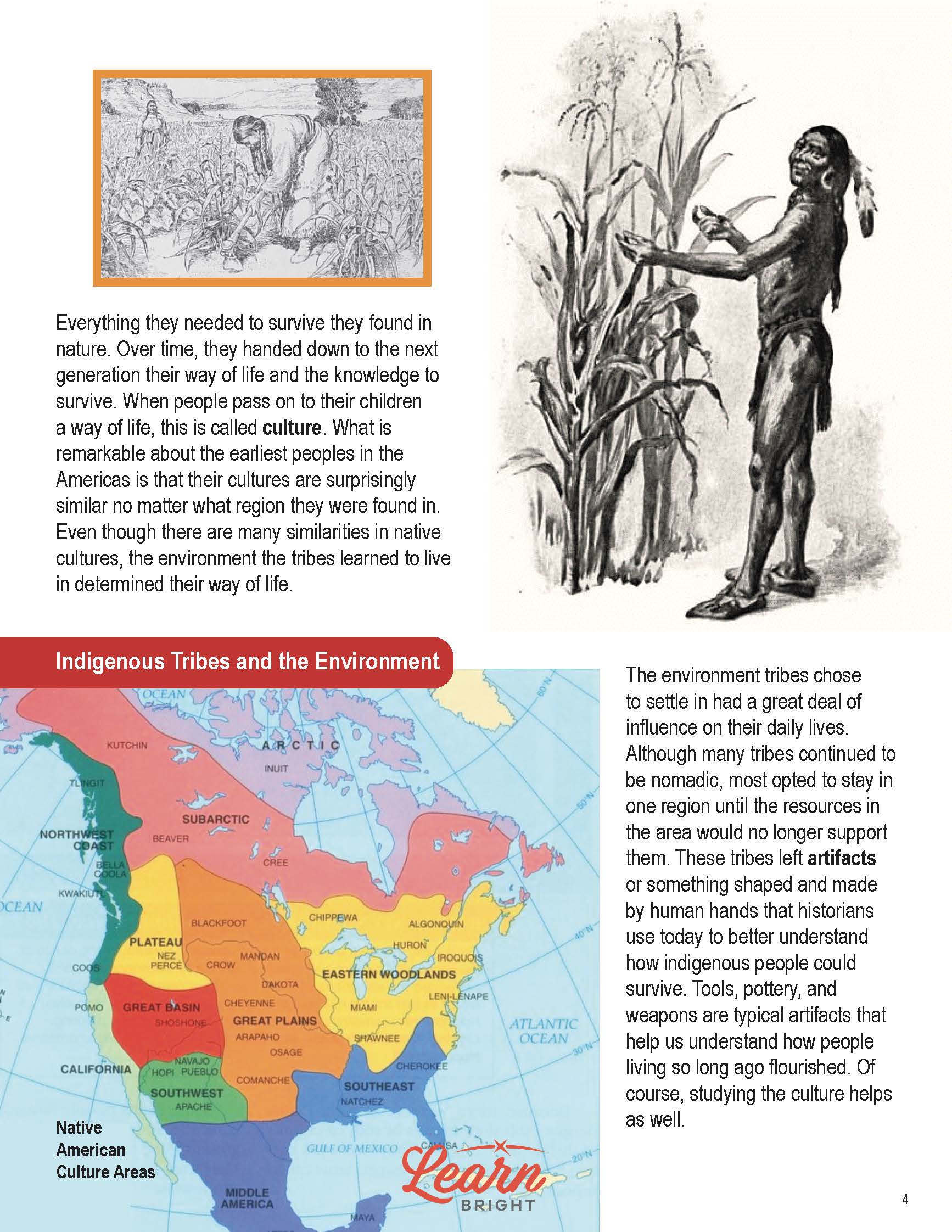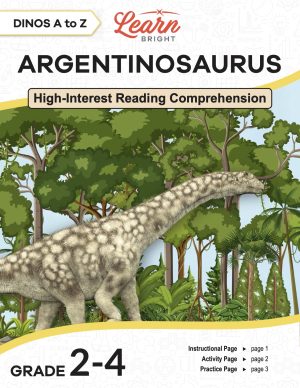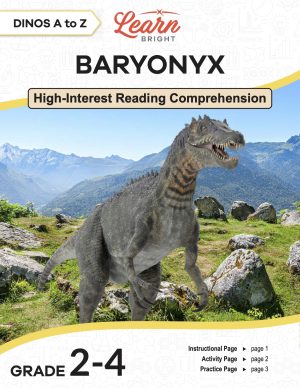Description
What our Earliest Peoples in America lesson plan includes
Lesson Objective and Overview: Earliest Peoples in America teaches students all about how the American continent was populated and who were the first indigenous peoples. Students will learn about how indigenous populations use the natural resources of an area to form their unique cultures and how stories and myths that explain natural events are essential to the culture of early people migrating to the Americas. This lesson is for students in 3rd grade, 4th grade, and 5th grade.
Classroom Procedure
Every lesson plan provides you with a classroom procedure page that outlines a step-by-step guide to follow. You do not have to follow the guide exactly. The guide helps you organize the lesson and details when to hand out worksheets. It also lists information in the yellow box that you might find useful. You will find the lesson objectives, state standards, and number of class sessions the lesson should take to complete in this area. In addition, it describes the supplies you will need as well as what and how you need to prepare beforehand. The supplies you will need for this lesson are pencils, pens, and highlighters.
Options for Lesson
Included with this lesson is an “Options for Lesson” section that lists a number of suggestions for activities to add to the lesson or substitutions for the ones already in the lesson. The only suggested addition to this lesson is to have your students use the website linked in the Options for Lesson section to find fun outdoor games that your students can play just like the early American people did.
Teacher Notes
The teacher notes page includes a paragraph with additional guidelines and things to think about as you begin to plan your lesson. This page also includes lines that you can use to add your own notes as you’re preparing for this lesson.
EARLIEST PEOPLES IN AMERICA LESSON PLAN CONTENT PAGES
The Earliest Peoples in America
The Earliest Peoples in America lesson plan includes three content pages. America has not always had so many people. Historians believe that the first humans arrived in North America 27,000 years ago.
Scientists used geologic evidence from rocks and fossils to figure out that the world was once covered in ice. At this time, a frozen land bridge called Beringia connected North America and Asia. Early people likely crossed this land bridge to hunt large animals like Wooly Mammoths. Hunters used these animals for materials to make clothes, tools, food, and shelter. The world started warming about 10,000 years ago, which melted the ice bridge and stopped further migration. Migration is when people move from one region to another.
Other early people might have arrived by boat. People migrated to North America from other continents, like Africa and Europe. Humans migrated to almost the entire North American continent over the next 1,000 years or so.
Early humans were hunter-gatherers, which meant they hunted for food and ate plants that they found. Humans started becoming less nomadic and started practicing agriculture instead of moving around in search of food. This means that 8,000 or 9,000 years ago, indigenous tribes started settling. These tribes successfully adapted to their environment.
These people found what needed in nature, and handed this knowledge down through the generations. Passing a way of life onto your children is an early version of culture. Many of the early people had very similar cultures, no matter which region they lived in. There were a lot of similarities between groups. However, the local environment also had a big impact on the way that people lived.
Indigenous Tribes and the Environment
The environment that tribes settled in had a huge influence on their lives. Many tribes stayed nomadic, but most decided to stay in one place until they had to move to find more resources. Tribes left artifacts, things shaped and made by human hands. Today, scientists use these artifacts to better understand how these tribes survived. Some of these artifacts included tools, pottery, and weapons. They also study the cultures of each group.
Native tribes used their environments in many ways. They influenced the shelters they built to live in. Along the Pacific Coast, tribes built log homes because there are many trees. In the Southwest, however, the climate is hot and dry with few trees. These tribes therefore built their homes from clay and stones.
The Western Plains have rolling hills, and the tribes there relied on the buffalo for shelters, clothing, and good. These tribes sometimes stayed semi-nomadic, following the buffalo. Tribes also lived in the Southeast, which has a mild climate and swamps, rivers, and lakes. This was a good environment for the tribes, who had lots of animals to hunt, forests for building supplies, and plants to eat.
The earliest Americans migrated from Asia and Europe, and were the first to inhabit the American continent. They were hunter-gatherers who quickly adapted to their environments. Many of these groups had similar cultures, while their environments dictated the specifics of their living conditions. When they first arrived, they roamed freely. However, Europeans arrived in the 1500s and brought death and diseases. The Europeans eradicated many of their cultures and lifestyles.
EARLIEST PEOPLES IN AMERICA LESSON PLAN WORKSHEETS
The Earliest Peoples in America lesson plan includes three worksheets: an activity worksheet, a practice worksheet, and a homework assignment. You can refer to the guide on the classroom procedure page to determine when to hand out each worksheet.
NATIVE AMERICAN CULTURE AREA ACTIVITY WORKSHEET
For the activity worksheet, students will use the Native American Culture Area map to locate the region that they live in. They will then complete the chart on the worksheet which asks them to describe the climate and natural resources, and to research the indigenous tribe for their region.
STORY PRACTICE WORKSHEET
The practice worksheet asks students to read a story about a Native American myth and answer five questions about it.
EARLIEST PEOPLES IN AMERICA HOMEWORK ASSIGNMENT
For the homework assignment, students will write a story about the picture printed on the assignment page, which is a picture of a wooly mammoth hunt.
Worksheet Answer Keys
This lesson plan includes answer keys for the practice worksheet. If you choose to administer the lesson pages to your students via PDF, you will need to save a new file that omits these pages. Otherwise, you can simply print out the applicable pages and keep these as reference for yourself when grading assignments.









